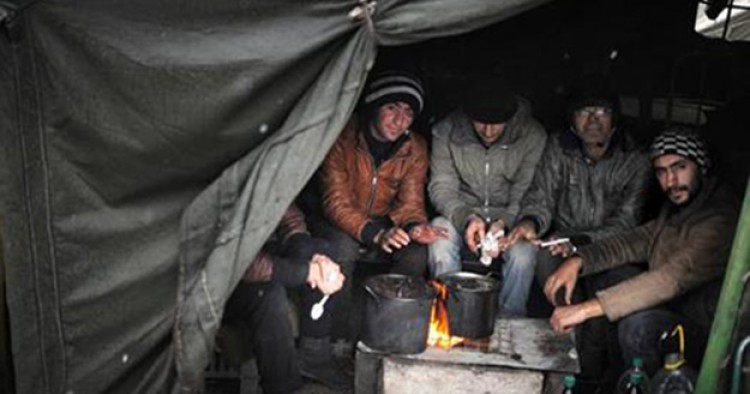“Amal”[1] fled violence in the countryside outside of Damascus with her husband, father, and five children almost two years ago. The family moved to Salamieh, a Syrian town of approximately 100,000 people 33 kilometers southeast of Hama. Salamieh is still under the control of the government armed forces, and many displaced people, mainly Sunnis from Homs, Aleppo, and the Damascus area, have sought refuge there and in surrounding towns. Salamieh also has the reputation of being a diverse and tolerant community, where different political groups, sects, and ethnicities live in relative harmony, and Amal hoped it would be a safe haven. But the city, like all of Syria, has not escaped transformation due to the conflict. Last year, a car bomb ripped through Hama Street in the town’s major business district, killing 43 people, mostly civilians. Internet statements claimed that Jabhat al-Nusra, a terrorist organization with alleged links to al-Qa`ida, was responsible, but a clear perpetrator was never confirmed.
Amal and her family have been living in a deserted house, with the windows covered by nylon bags and a decrepit roof layered in zinc tiles, easily penetrated by rain and snow. Amal’s 75-year-old father passed away after a snowstorm hit the city in early December 2013. “He was healthy, but couldn’t take the cold,” she said. “We don’t have any source of heat or electricity.” Two of her boys, 10 and 12, are going untreated for hepatitis A, as the vaccine has not been available. The boys earn a small amount by transporting heavy loads in the city’s souk, wearing only plastic sandals and thin shirts in the cold. A source close to the family says the boys are “close to death,” but they refuse to stop working in order to bring in the small sum.
Throughout the country, millions of men, women, and children like Amal and her family have been forced from their homes and livelihoods. The cold winter and poverty have become as threatening as bombs and bullets. Without fuel, electricity, or shelter, many Syrians have been suffering in what is considered to be the coldest winter in memory.
And as the number of internally displaced in Salamieh continues to rise—approximately 100,000, or double the usual population—space is becoming limited to the point that some families are left to live on rooftops, and others must shelter in tents.
Ahmad and his wife and four children are one such family forced to live in a meager shelter. They fled Homs last year and sought refuge in Marj Matar, a village close to Salamieh. Ahmad has been living with his family in a handmade tent. “I stitched some gunny sacks and plastic sheets together,” he said. To secure the tent against the wind, the family filled bags with stones and sand, and covered the ground with plastic bags and worn out carpets. “We left everything behind, but people have been generous to us,” said Ahmad. “They are poor as well, but they have donated pots, blankets, and old clothes.” To keep warm, Ahmad and other families spend every day searching for wood and sticks for fires for heat and cooking. “We are burning everything, including garbage,” he explained. “Finding garbage is becoming difficult.”
The International Committee of the Red Cross has been coordinating with relief organizations such as the Syrian Arab Red Crescent, Al Birr Charity, and the Aga Khan Foundation (AKF) to distribute supplies to the displaced, such as food baskets and blankets. “We rely on the support of people in Salamieh and abroad,” said Iman Bader, a 29-year-old from Salamieh who volunteers both independently and with various relief agencies. Bader has been collecting packs of wool and distributing them among local and displaced women to knit into scarves, gloves, and socks for children. Some owners of farms and chicken coops have offered up their spaces for the displaced seeking refuge. In exchange, the families guard and maintain the property.
While displaced people are suffering the most, many local families are freezing as well. Fuel is very rare and expensive; a liter (quarter gallon) costs about 100 Syrian pounds (55 cents), a price that could buy a family two days worth of bread. Farieha al-Felastini, a single mother with three children, is more fortunate as she has a home with a roof and windows. However, because houses in Syria are built of cement, they can take hours to heat. Al-Felastini had a heater in each room, but with the rising cost of fuel, she is forced to use a firewood furnace in the living room. She and others are randomly cutting down trees, destroying forests in order to survive. “With the cold, we do not have a choice,” she said. People are staying home, wearing layers, and covering themselves with thick blankets. “When electricity is available, we use a small electrical heater,” said Reem Wardeh, a Salamieh resident with three children. “But sometimes the power goes off for ten hours straight.”
Bader reports that international support has mainly consisted of food, with people left on their own to deal with the cold and with illness. Though the area is continuously promised additional humanitarian support, supplies have remained limited and are inadequate to cover increasing needs.
“There is bombing, destruction, and injustice on one side, and cold and starvation on the other,” said Amal. “My hope is no longer to go back to my home or to have a house—my hope is for summer to arrive.”
The Middle East Institute (MEI) is an independent, non-partisan, non-for-profit, educational organization. It does not engage in advocacy and its scholars’ opinions are their own. MEI welcomes financial donations, but retains sole editorial control over its work and its publications reflect only the authors’ views. For a listing of MEI donors, please click here.













